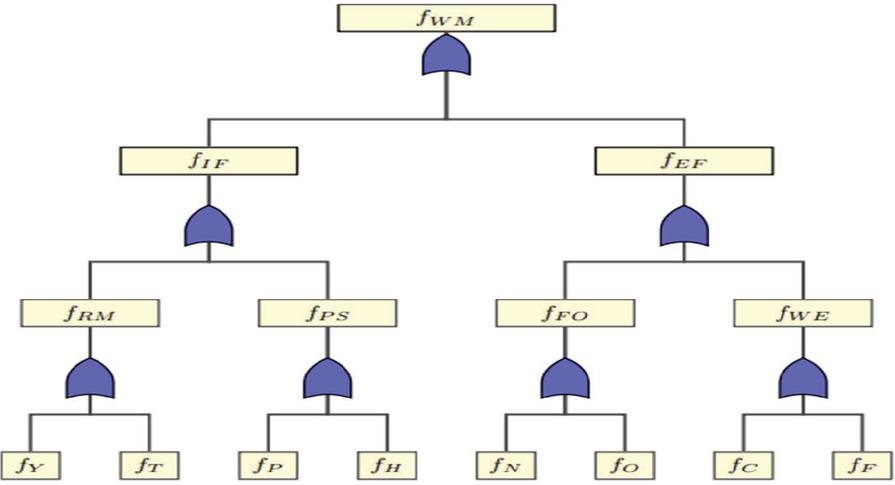A Study On Reliability Using Pendant, Hexant, Octant Fuzzy Numbers
P. Jini Varghese* and G. Michael Rosario
PG and Research Department of Mathematics, Jayaraj Annapackiam College for Women (Autonomous), Periyakulam, Theni
(Affiliated to Mother Teresa Women’s University, Kodaikanal)
E-mail: jinijees@gmail.com; tony87rio@gmail.com
Corresponding Author
Received 11 March 2021; Accepted 29 August 2021; Publication 09 October 2021
Abstract
The weaving machine’s reliability is assessed using newly introduced fuzzy numbers. The fuzzy numbers introduced in this study give a better method to improve the reliability than other techniques. Pendant Fuzzy Number, Hexant Fuzzy Number, and Octant Fuzzy Number are all introduced in this present study. Pendant Fuzzy Number, Hexant Fuzzy Number, and Octant Fuzzy Number,-cuts are defined, as well as their mathematical operations. The numerical examples are utilised to conduct a comparative research of reliability using various Fuzzy Numbers, and their defuzzification is accomplished using various ways such as Signed Distance method, Graded Mean Integration Method and Centroid Method. The purpose of this study is to discover the most reliable value for a weaving machine.
Keywords: Pendant fuzzy number, Triangular Pendant fuzzy number, Trapezoidal Pendant fuzzy number, Pentagonal Pendant fuzzy number, Hexant fuzzy number, Triangular Hexant fuzzy number, Trapezoidal Hexant fuzzy number, Pentagonal Hexant fuzzy number, Octant fuzzy number, Triangular Octant fuzzy number, Trapezoidal Octant fuzzy number, Pentagonal Octant fuzzy number.
1 Introduction
The term “reliability” refers to a touchy subject in engineering and applied sciences. Traditional reliability assessment methods are mostly reliant on crisp or accurate data, making them ineffective at reflecting the uncertainty inherent in human judgment. In practice, though, there are underlying systems whose information isn’t always as precise as it appears. As a result, the uncertainties associated with components, parameters, phenomena, and underlying assumptions are frequently addressed in a reliability study.
Objective of the Study
To prevent the occurrence of failures by using engineering knowledge and specialized approaches and to the reasons of failures that occurs despite best attempts to avoid them. Also to figure out how to deal with failures that do happen if the causes haven’t been solved and to apply methodologies for estimating new model reliability and analyzing reliability data.
Scope of the Study
Structural, aerospace, biomechanical, mechanical, and electrical engineering are just a few of the engineering and technology domains where applications can be found. This study may also address the most significant current achievements in the field of stochastic engineering techniques by using fuzzy numbers.
Purpose of the Study
The weaving machine’s reliability is assessed using newly introduced fuzzy numbers. The fuzzy numbers introduced in this study give a better method to improve the reliability than other techniques. All varieties of triangular fuzzy numbers have the same representation, but their -cuts differ. In the defuzzification procedure, -cuts are used. The purpose of this project is to discover the most reliable value for a weaving machine.
Limitations and Future Scope of the Work
We can build a system with high reliability in the future, which will lead to the construction of a new machine. It is done with the help of a system’s failure and reliability evaluation. Evaluation of failure factors is also carried out in order to determine which elements contribute to low reliability and which factors may be addressed to keep the machine stable.
Maintenance can be further be classified into two types namely breakdown and planned or unscheduled maintenance and scheduled maintenance or planned maintenance and unplanned maintenance. Routine maintenance is usually pre-planned and consists of scheduled inspections, repairs, and replacements to ensure that everything is in working order. It’s comparable to a machine that needs to be serviced on a regular basis. Corrective maintenance is required when things go wrong or break down, prompting immediate effort to get things back up and running. It’s comparable to having a machine repaired when a part has failed.
Literature Review
Many authors have studied the assessment of reliability systems based under uncertainty since Zadeh’s presentation of the fuzzy set in 1965 in [1]. Various methodologies and theories for dealing with imprecision and uncertainties have been proposed throughout the years, with the goal of generalising classical reliability systems to ambiguous systems of interest. In [2], Panda (2016) suggested a method for assessing the fuzzy reliability of multistage interconnection networks using the fuzzy probability of disjunct terms over all path sets. In [3], He Q et al. (2017) proposed a reliability analysis method for multi-state systems based on a triangular fuzzy variety subset Bayesian network, which takes into account fuzziness, multi-state nature, and a wide range of failure probabilities. Mahapatra and Roy (2012) in [4], developed a method for evaluating the reliability of a system made of components with fuzzy reliability based on Zadeh’s extension principle and interval arithmetic operations on fuzzy numbers. In [5], Jamkhaneh (2011) used an exponential distribution with fuzzy parameters to characterise component lifetimes when developing the system reliability evaluation problem. In [6], Hussian and Amin (2017) explored how to estimate stress-strength models using a fuzzy membership function defined as a function of the difference between stress and strength values. Aliev and Kara (2004) in [7], developed a general technique for creating the membership function of the fuzzy reliability using the confidence interval and time-dependent fuzzy set theory when the failure rate was fuzzy. When the stress is a random variable and the strength is unchanging, Dong et al. (2003) in [8], proposed a model for studying fuzzy reliability. In [9], Wu (2004) suggested a method of Bayesian reliability estimation in a fuzzy environment with fuzzy prior distributions for the parameters. In [10], Sharma (2017) used the notion of fuzzy possibility to construct several common series reliability, such as parallel, bridge, and k-out-of-n network systems. Kumar and Bajaj (2014) proposed a methodology for measuring the intuitionistic fuzzy system reliability of a k-out-of-n system based on exact data and intuitionistic fuzzy parameters using intuitionistic fuzzy confidence intervals in [11]. In [12], Chaube et al. (2016) investigated the fuzzy reliability of a two-stage weighed k-out-of-n model with fuzzy components. In [13], Lee et al. (2012) expanded the reliability of a parallel system based on interval-valued fuzzy numbers to fuzzy reliability of parallel systems and used the signed distance approach to assess the system’s reliability in a fuzzy sense. Kumar and Yadav (2012) in [14], developed the traditional cases in which all components of a system failed at the same time, using the same style of intuitionistic fuzzy set. Using time-dependent intuitionistic fuzzy failure rates, Kumar et al. (2013) in [15], developed a universal approach for creating membership and non-membership functions of the fuzzy reliability. In [16], Razak et al. (2013) proposed a method for analysing the reliability of a fuzzy system based on a fuzzy semi-Markov model with fuzzy transitions, with the fuzzy model’s findings given as trapezoidal fuzzy numbers. In [17], Rao et al. (2009) suggested a method to generate various uncertainty importance measures in fuzzy reliability analysis in order to rank the components based on their uncertainty contribution to the overall system reliability uncertainty. Using a hybrid algorithm based on fuzzy simulation and failure mode and effect analysis, Xu and Mitra (2010) in [18], suggested an approach based on credibility theory to evaluate distribution system reliability. As previously mentioned, several ways for evaluating system reliability based on intuitionistic fuzzy information have been developed; they are mostly focused on the intuitionistic fuzzy component of each system or the intuitionistic fuzzy failure rate. Rezvani. S (2011) discussed the multiplication operation on trapezoidal fuzzy numbers in [19]. Trident fuzzy numbers were introduced by A. Praveen Prakash and G. Geetha Lakshmi (2016) in [20], who detailed the arithmetic processesB. Rama and G. Michael Rosario (2019), in [21, 22], investigated the penalty cost and shortage cost utilising various fuzzy numbers, particularly trident fuzzy numbers, and expanded the notion to quadrant fuzzy numbers, as well as discussing their arithmetic operations. Nagoorgani. A (2012) in [23], described a new procedure on triangular fuzzy numbers that can be utilised to solve the linear programming problem. In [24], Avinash J Kamble (2017) included a note on pentagonal Fuzzy numbers. G. Menaka (2017) in [25] explored and investigated the features of octagonal intuitionistic fuzzy numbers. S. Resvani (2015) in [26] used trapezoidal fuzzy numbers to evaluate a variance study HesamoddinTahami and HengamehFakhravar (2020) investigated the fuzzy inventory model with excellent quality items in [27]. RituparnaPakhira, Uttam Ghosh, and Susmita Sarkar (2019) conducted a shortage cost analysis in the Fuzzy inventory model in [28]. Fuzzy numbers and their applications in difference equations were employed by Sankar Prasad, Manimohan Mandal, and Pebasish Bhattacharya (2017) in [29]. The reliability of intuitionistic fuzzy numbers was investigated by G. Michael Rosario and Dhanalakshmi (2015) in [30]. L.S Srinath (2016) in [31] and Charles E. Ebeling (2017) in [32] provide an introduction to reliability and the application of reliability in engineering. P. Jini Varghese and G. Michael Rosario (2018) investigated the reliability of a weaving machine using various fuzzy numbers, and the reliability of the probist system was described using fuzzy numbers [33–35].
Structure of the Study
The following is the paper’s structure: New Fuzzy Numbers, such as Pendant Fuzzy Numbers, Hexant Fuzzy Numbers, and Octant Fuzzy Numbers, are introduced in Section 2, along with their types and its mathematical operations. The fuzzy reliability of the weaving machine is calculated using the probability technique in Section 3. Section 4 illustrates with numerical examples to calculate the reliability of a weaving machine using Pendant, Hexant, and Octant Fuzzy Numbers. Defuzzification techniques such as Signed Distance Method, Graded Mean Integration Method, and Centroid Method are applied in Section 5. In Section 6, the reliability of a weaving machine is compared using graphs and tables and conclusion is given in Section 7.
2 Types of Pendant Fuzzy Number
2.1 Definitions
A few fuzzy numbers are introduced, together with their definitions, representations, -cuts, and arithmetic operations. For a fuzzy set and, then the -cut is defined as , where X is the universal set. Upper and lower bounds are and respectively.
The -cut is critical for determining the defuzzification value. Although the representations of several types of triangular fuzzy numbers are similar, their -cuts differ. As a result, a -cut is essential in the defuzzification process. In the case of Trapezoidal and Pentagonal Fuzzy Numbers, the situation is similar.
2.1.1 Triangular pendant fuzzy number (TPFN)
A Triangular Pendant Fuzzy Number is given by where are real numbers and then its membership function is defined as
| (1) |
-cut of a Triangular Pendant Fuzzy Number is given by
| (2) |
Arithmetic Operations of Triangular Pendant Fuzzy Number
1. Addition
If , are two Triangular Pendant Fuzzy Numbers then addition is given by
2. Subtraction
If , are two Triangular Pendant Fuzzy Numbers then subtraction is given by
2.1.2 Trapezoidal pendant fuzzy number (TrPFN)
A Trapezoidal Pendant Fuzzy Number is given by where are real numbers and , then its membership function is defined as
| (3) |
-cut of a Trapezoidal Pendant Fuzzy Number is given by
| (4) |
Arithmetic Operations of Trapezoidal Pendant Fuzzy Number
1. If , are two Trapezoidal Pendant Fuzzy Numbers then addition is defined by
2. If , are two Trapezoidal Pendant Fuzzy Numbers then subtraction is defined by
2.1.3 Pentagonal pendant fuzzy number (PenPFN)
A Pentagonal Pendant Fuzzy Number is given by where are real numbers and , then its membership function is defined as
| (5) |
-cut of a Pentagonal Pendant Fuzzy Number is given by
| (6) | |
| (7) |
Arithmetic Operations of Pentagonal Pendant Fuzzy Number
1. If , , are two Pentagonal Pendant Fuzzy Numbers then addition is defined by
2. If , , are two Pentagonal Pendant Fuzzy Numbers then subtraction is defined by
2.1.4 Triangular hexant fuzzy number (THFN)
A Triangular Hexant Fuzzy Number is given by where are real numbers and then its membership function is defined as
| (8) |
-cut of a Triangular Hexant Fuzzy Number is given by
| (9) |
Arithmetic Operations of Triangular Hexant Fuzzy Number
1. If , are two Triangular Hexant Fuzzy Numbers then addition is given by
2. If , are two Triangular Hexant Fuzzy Numbers then subtraction is given by
2.1.5 Trapezoidal hexant fuzzy number (TrHFN)
A Trapezoidal Hexant Fuzzy Number is given by where are real numbers and , then its membership function is defined as
| (10) |
-cut of a Trapezoidal Hexant Fuzzy Number is given by
| (11) |
Arithmetic Operations of Trapezoidal Hexant Fuzzy Number
1. If , are two Trapezoidal Hexant Fuzzy Numbers then addition is defined by
2. If , are two Trapezoidal Hexant Fuzzy Numbers then subtraction is defined by
2.1.6 Pentagonal hexant fuzzy number (PenHFN)
A Pentagonal Hexant Fuzzy Number is given by where are real numbers and , then its membership function is defined as
| (12) |
-cut of a Pentagonal Hexant Fuzzy Number is given by
| (13) | ||
| (14) |
Arithmetic Operations of Pentagonal Hexant Fuzzy Number
1. If , , are two Pentagonal Hexant Fuzzy Numbers then addition is defined by
2. If , , are two Pentagonal Hexant Fuzzy Numbers then subtraction is defined by
2.1.7 Triangular octant fuzzy number (TOFN)
A Triangular Octant Fuzzy Number is given by where are real numbers and then its membership function is defined as
| (15) |
-cut of a Triangular Octant Fuzzy Number is given by
| (16) |
Arithmetic Operations of Triangular Octant Fuzzy Number
1. If , are two Triangular Octant Fuzzy Numbers then addition is given by
2. If , are two Triangular Octant Fuzzy Numbers then the subtraction is given by
2.1.8 Trapezoidal octant fuzzy number (TrOFN)
A Trapezoidal Octant Fuzzy Number is given by , where are real numbers and , then its membership function is defined as
| (17) |
-cut of a Trapezoidal Octant Fuzzy Number is given by
| (18) |
Arithmetic Operations of Trapezoidal Octant Fuzzy Number
1. If , are two Trapezoidal Octant Fuzzy Numbers then addition is defined by
2. If , are two Trapezoidal Octant Fuzzy Numbers then subtraction is defined by
2.1.9 Pentagonal octant fuzzy number (PenOFN)
A Pentagonal Octant Fuzzy Number is given by where are real numbers and , then its membership function is defined as
| (19) |
-cut of a Pentagonal Octant Fuzzy Number is given by
| (20) | ||
| (21) |
Arithmetic Operations of Pentagonal Octant Fuzzy Number
1. If , , are two Pentagonal Octant Fuzzy Numbers then the addition is defined by
2. If , , are two Pentagonal Octant Fuzzy Numbers then the subtraction is defined by
3 Reliability and Failure Rate of Weaving Machine
Figure 1 Fault tree diagram of weaving machine.
Failure of a weaving machine depends on the following factors
| Failure rate of physical stabilities | Failure rate of controlled humidity | ||
| Failure rate of internal factors | Failure rate of balanced pressure | ||
| Failure rate of external factors | Failure rate of quality of the thread | ||
| Failure rate of physical stabilities | Failure rate of continuous filament yarn | ||
| Failure rate of row materials | Failure rate of availability of the fuel | ||
| Failure rate of working energy | Failure rate of the balanced current flow | ||
| Failure rate of flow of lubricants oil | Failure rate of shortage of lubricants oil | ||
| Failure rate due to nozzles blocked |
We can calculate the failure of the internal factors involved in the system using Probability Method. Here, the failure of the internal factors occurs when ff or ff or ff or ffoccurs.
The probability of the failure of the system is the probability of the failure of the internal factors and the probability of the failure of the external factors.
Failure of the internal factors involved in the system is
| (22) |
Here we assume the elements are independent.
Reliability of the system=1-probability of failure
Therefore, Probability of failure=1-Reliability of the system.
| Reliability of physical stabilities | Reliability of controlled humidity | ||
| Reliability of internal factors | Reliability of balanced pressure | ||
| Reliability of external factors | Reliability of quality of the thread | ||
| Reliability of physical stabilities | Reliability of continuous filament yarn | ||
| Reliability of row materials | Reliability of availability of the fuel | ||
| Reliability of working energy | Reliability of the balanced current flow | ||
| Reliability of flow of lubricants oil | Reliability of shortage of lubricants oil | ||
| Reliability due to nozzles blocked |
So,
Therefore,
| (23) |
Failure of the external factors involved in the system is
| (24) | ||
Therefore,
| (25) |
Failure of the weaving machine is the sum of the internal failure and the external failure of the system.
Therefore,
| (26) |
So, the reliability of the system
| (27) |
4 Numerical Evaluation
Let us consider arbitrary fuzzy values for Triangular Fuzzy Number, Triangular Pendant Fuzzy Number, Triangular Hexant Fuzzy Number, Triangular Octant Fuzzy Number, Trapezoidal Fuzzy Number, Trapezoidal Pendant Fuzzy Number, Trapezoidal Hexant Fuzzy Number, Trapezoidal Octant Fuzzy Number, Pentagonal Fuzzy Number, Pentagonal Pendant Fuzzy Number, Pentagonal Hexant Fuzzy Number and Pentagonal Octant Fuzzy Number to evaluate the reliability evaluation of Weaving Machine.
4.1 Using Triangular Fuzzy Number, Triangular Pendant Fuzzy Number, Triangular Hexant Fuzzy Number and Triangular Octant Fuzzy Number
Let us consider the values as follows:
Using these values in (27)
| (28) |
Triangular Fuzzy Number, Triangular Pendant Fuzzy Number, Triangular Hexant Fuzzy Number, and Triangular Octant Fuzzy Number all have the same representation, but their -cuts differ. So, for Triangular Fuzzy Number, Triangular Pendant Fuzzy Number, Triangular Hexant Fuzzy Number, and Triangular Octant Fuzzy Number, the values of all the failure factors are the same, and the reliability is likewise the same.
4.2 Using Trapezoidal Fuzzy Number, Trapezoidal Pendant Fuzzy Number, Trapezoidal Hexant Fuzzy Number and Trapezoidal Octant Fuzzy Number
Let us consider the values as follows:
Using these values in (27)
| (29) |
Trapezoidal Fuzzy Number, Trapezoidal Pendant Fuzzy Number, Trapezoidal Hexant Fuzzy Number, and Trapezoidal Octant Fuzzy Number all have the same representation, but their -cuts differ. So, for Trapezoidal Fuzzy Number, Trapezoidal Pendant Fuzzy Number, Trapezoidal Hexant Fuzzy Number, and Trapezoidal Octant Fuzzy Number, the values of all the failure factors are the same, and the reliability is likewise the same.
4.3 Using Pentagonal Fuzzy Number, Pentagonal Pendant Fuzzy Number, Pentagonal Hexant Fuzzy Number and Pentagonal Octant Fuzzy Number
Let us consider the values as follows:
Using these values in (27)
| (30) |
Pentagonal Fuzzy Number, Pentagonal Pendant Fuzzy Number, Pentagonal Hexant Fuzzy Number, and Pentagonal Octant Fuzzy Number all have the same representation, but their -cuts differ. So, for Pentagonal Fuzzy Number, Pentagonal Pendant Fuzzy Number, Pentagonal Hexant Fuzzy Number, and Pentagonal Octant Fuzzy Number, the values of all the failure factors are the same, and the reliability is likewise the same.
5 Defuzzification Methods
The process of defuzzification is the inverse of fuzzification. In the case of a comparison study, the defuzzification plan is vital. We cannot determine the exact reliability from a fuzzy number but because the fuzzy number is changed to a crisp value throughout the defuzzification process, we can easily determine which value is more reliable.
Let denotes the reliability of the weaving machine.
5.1 Signed Distance Method
The fuzzy numbers in this study can be defuzzified by Signed Distance Method and the defuzzified values for is given by the formula:
| (31) |
Here, and are the lower and upper limit of -cut respectively.
5.1.1 Signed distance method for triangular fuzzy number
Considering Triangular Fuzzy Number the defuzzified value of using Signed Distance Method is given by
| (32) |
5.1.2 Signed distance method for triangular pendant fuzzy number
Considering Triangular Pendant Fuzzy Number the defuzzified value of using Signed Distance Method is given by
| (33) |
5.1.3 Signed distance method for Triangular Hexant Fuzzy Number
Considering Triangular Hexant Fuzzy Number the defuzzified value of using Signed Distance Method is given by
| (34) |
5.1.4 Signed distance method for Triangular Octant Fuzzy Number
Considering Triangular Octant Fuzzy Number the defuzzified value of using Signed Distance Method is given by
| (35) |
5.1.5 Signed distance method for Trapezoidal Fuzzy Number
Considering Trapezoidal Fuzzy Number the defuzzified value of using Signed Distance Method is given by
| (36) |
5.1.6 Signed distance method for Trapezoidal Pendant Fuzzy Number
Considering Trapezoidal Pendant Fuzzy Number , the defuzzified value of using Signed Distance Method is given by
| (37) |
5.1.7 Signed distance method for Trapezoidal Hexant Fuzzy Number
Considering Trapezoidal Hexant Fuzzy Number , the defuzzified value of using Signed Distance Method is given by
| (38) |
5.1.8 Signed distance method for Trapezoidal Octant Fuzzy Number
Considering Trapezoidal Octant Fuzzy Number , the defuzzified value of using Signed Distance Method is given by
| (39) |
5.1.9 Signed distance method for Pentagonal Fuzzy Number
Considering Pentagonal Fuzzy Number the defuzzified value of using Signed Distance Method is given by
| (40) |
5.1.10 Signed distance method for Pentagonal Pendant Fuzzy Number
Considering Pentagonal Pendant Fuzzy , Number the defuzzified value of using Signed Distance Method is given by
| (41) |
5.1.11 Signed distance method for Pentagonal Hexant Fuzzy Number
Considering Pentagonal Hexant Fuzzy Number , the defuzzified value of using Signed Distance Method is given by
| (42) |
5.1.12 Signed distance method for Pentagonal Octant Fuzzy Number
Considering Pentagonal Octant Fuzzy Number , the defuzzified value of using Signed Distance Method is given by
| (43) |
5.2 Graded Mean Integration Method
The fuzzy numbers in this study can be defuzzified by Graded Mean Integration Method and the defuzzified values for are given by the formula:
| (44) |
where and are the lower and upper limit of -cut respectively.
5.2.1 Graded mean integration method for Triangular Fuzzy Number
Considering Triangular Fuzzy Number the defuzzified value of using Graded Mean Integration Method is given by
| (45) |
5.2.2 Graded mean integration for Triangular Pendant Fuzzy Number
Considering Triangular Pendant Fuzzy Number the defuzzified value of using Graded Mean Integration Method is given by
| (46) |
5.2.3 Graded mean integration for Triangular Hexant Fuzzy Number
Considering Triangular Hexant Fuzzy Number the defuzzified value of using Graded Mean Integration Method is given by
| (47) |
5.2.4 Graded mean integration for Triangular Octant Fuzzy Number
Considering Triangular Octant Fuzzy Number the defuzzified value of using Graded Mean Integration Method is given by
| (48) |
5.2.5 Graded mean integration method for Trapezoidal Fuzzy Number
Considering Trapezoidal Fuzzy Number the defuzzified value of using Graded Mean Integration Method is given by
| (49) |
5.2.6 Graded mean integration for Trapezoidal Pendant Fuzzy Number
Considering Trapezoidal Pendant Fuzzy Number , the defuzzified value of using Graded Mean Integration Method is given by
| (50) |
5.2.7 Graded mean integration for Trapezoidal Hexant Fuzzy Number
Considering Trapezoidal Hexant Fuzzy Number , the defuzzified value of using Graded Mean Integration Method is given by
| (51) |
5.2.8 Graded mean integration for Trapezoidal Octant Fuzzy Number
Considering Trapezoidal Octant Fuzzy Number , the defuzzified value of using Graded Mean Integration Method is given by
| (52) |
5.2.9 Graded mean integration method for Pentagonal Fuzzy Number
Considering Pentagonal Fuzzy Number the defuzzified value of using Graded Mean Integration Method is given by
| (53) |
5.2.10 Graded mean integration for Pentagonal Pendant Fuzzy Number
Considering Pentagonal Pendant Fuzzy Number , the defuzzified value of using Graded Mean Integration Method is given by
| (54) |
5.2.11 Graded mean integration for Pentagonal Hexant Fuzzy Number
Considering Pentagonal Hexant Fuzzy Number , the defuzzified value of using Graded Mean Integration Method is given by
| (55) |
5.2.12 Graded mean integration for Pentagonal Octant Fuzzy Number
Considering Pentagonal Octant Fuzzy Number , the defuzzified value of using Graded Mean Integration Method is given by
| (56) |
5.3 Centroid Method
Again for different fuzzy numbers using Centroid Method, the defuzzified value for is given as follows
5.3.1 Centroid method for Triangular Fuzzy Number
Considering Triangular Fuzzy Number the defuzzified value of using centroid method is given by
| (57) |
5.3.2 Centroid method for Triangular Pendant Fuzzy Number
Considering Triangular Pendant Fuzzy Number the defuzzified value of using centroid method is given by
| (58) |
5.3.3 Centroid method for Triangular Hexant Fuzzy Number
Considering Triangular Hexant Fuzzy Number the defuzzified value of using centroid method is given by
| (59) |
5.3.4 Centroid method for Triangular Octant Fuzzy Number
Considering Trapezoidal Octant Fuzzy Number the defuzzified value of using centroid method is given by
| (60) |
5.3.5 Centroid method for Trapezoidal Fuzzy Number
Considering Trapezoidal Fuzzy Number the defuzzified value of using centroid method is given by
| (61) |
5.3.6 Centroid method for Trapezoidal Pendant Fuzzy Number
Considering Trapezoidal Pendant Fuzzy Number , the defuzzified value of using centroid method is given by
| (62) |
5.3.7 Centroid method for Trapezoidal Hexant Fuzzy Number
Considering Trapezoidal Hexant Fuzzy Number , the defuzzified value of using centroid method is given by
| (63) |
5.3.8 Centroid method for Trapezoidal Octant Fuzzy Number
Considering Trapezoidal Octant Fuzzy Number the defuzzified value of using centroid method is given by
| (64) |
5.3.9 Centroid method for Pentagonal Fuzzy Number
Considering Pentagonal Fuzzy Number the defuzzified value of using centroid method is given by
| (65) |
5.3.10 Centroid method for Pentagonal Pendant Fuzzy Number
Considering Pentagonal Pendant Fuzzy Number , the defuzzified value of using centroid method is given by
| (66) |
5.3.11 Centroid method for Pentagonal Hexant Fuzzy Number
Considering Pentagonal Hexant Fuzzy Number , the defuzzified value of using centroid method is given by
| (67) |
5.3.12 Centroid method for Pentagonal Octant Fuzzy Number
Considering Pentagonal Octant Fuzzy Number , the defuzzified value of using centroid method is given by
| (68) |
6 Analysis
6.1 Comparative Study Through Graph
The following table gives the crisp values for Triangular Fuzzy Number, Triangular Pendant Fuzzy Number, Triangular Hexant Fuzzy Number, Triangular Octant Fuzzy Number, Trapezoidal Fuzzy Number, Trapezoidal Pendant Fuzzy Number, Trapezoidal Hexant Fuzzy Number, Trapezoidal Octant Fuzzy Number, Pentagonal Fuzzy Number, Pentagonal Pendant Fuzzy Number, Pentagonal Hexant Fuzzy Number and Pentagonal Octant Fuzzy Number through the Defuzzification Techniques such as Signed Distance Method, Graded Mean Integration Method and Centroid Method.
6.1.1 Signed Distance Method
Table and Graph 1 Signed Distance Method of Triangular, Triangular Pendant, Triangular Hexant and Triangular Octant Fuzzy numbers
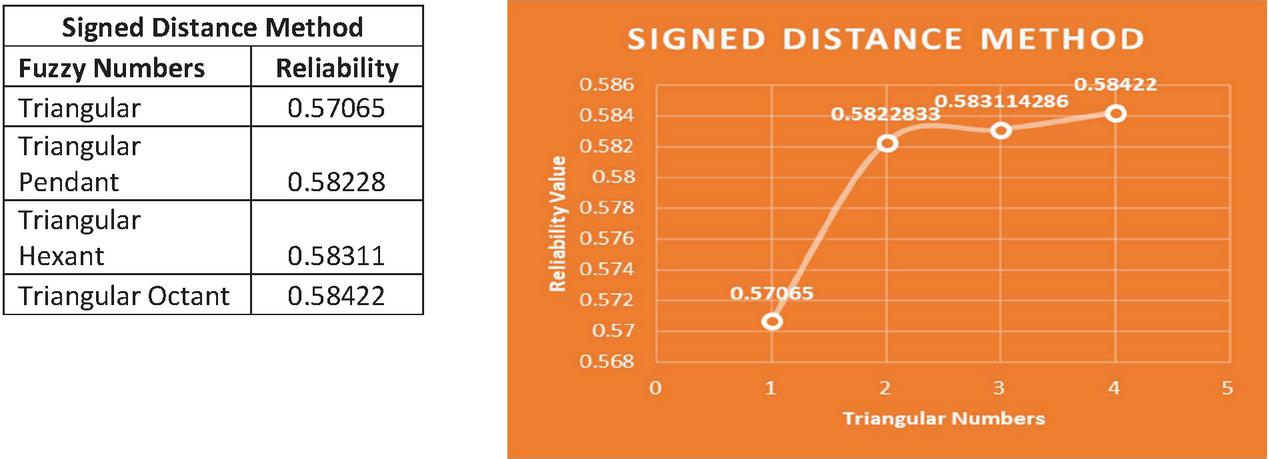 |
Table and Graph 2 Signed Distance Method of Trapezoidal, Trapezoidal Pendant, Trapezoidal Hexant and Trapezoidal Octant Fuzzy numbers
 |
Table and Graph 3 Signed Distance Method of Pentagonal, Pentagonal Pendant, Pentagonal Hexant and Pentagonal Octant Fuzzy numbers
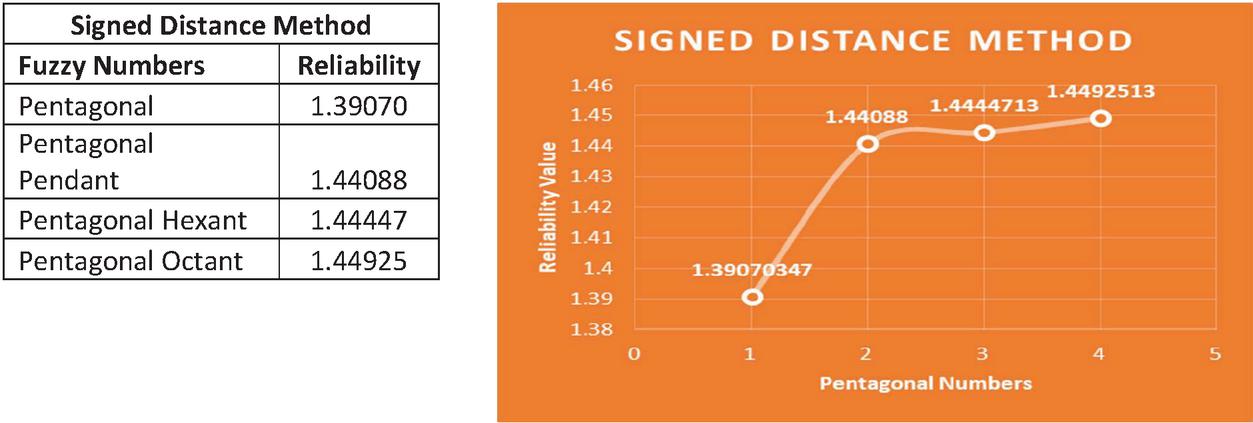 |
6.1.2 Graded Mean Integration Method
Table and Graph 4 Graded Mean Integration Method of Triangular, Triangular Pendant, Triangular Hexant and Triangular Octant Fuzzy numbers
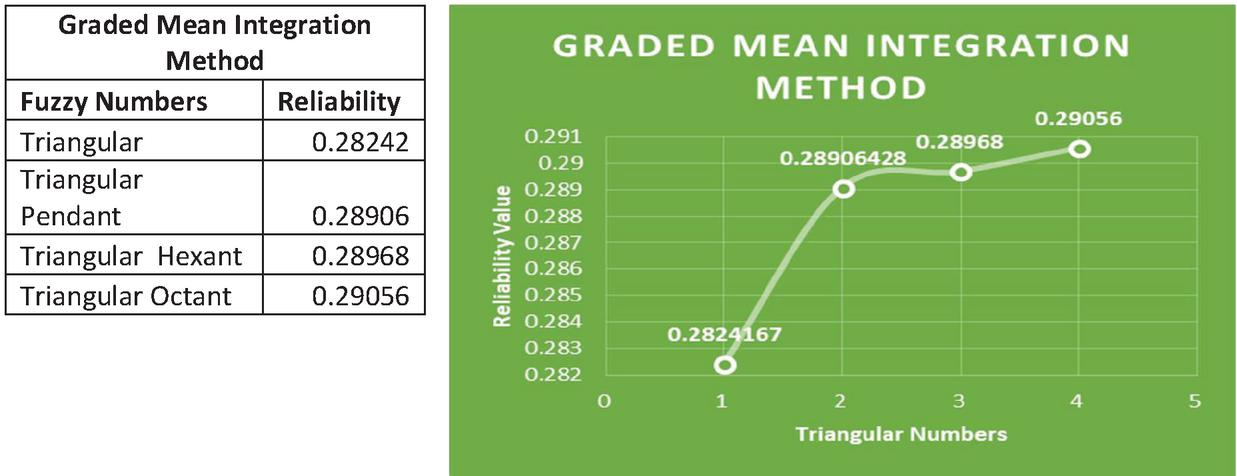 |
Table and Graph 5 Graded Mean Integration Method of Trapezoidal, Trapezoidal Pendant, Trapezoidal Hexant and Trapezoidal Octant Fuzzy numbers
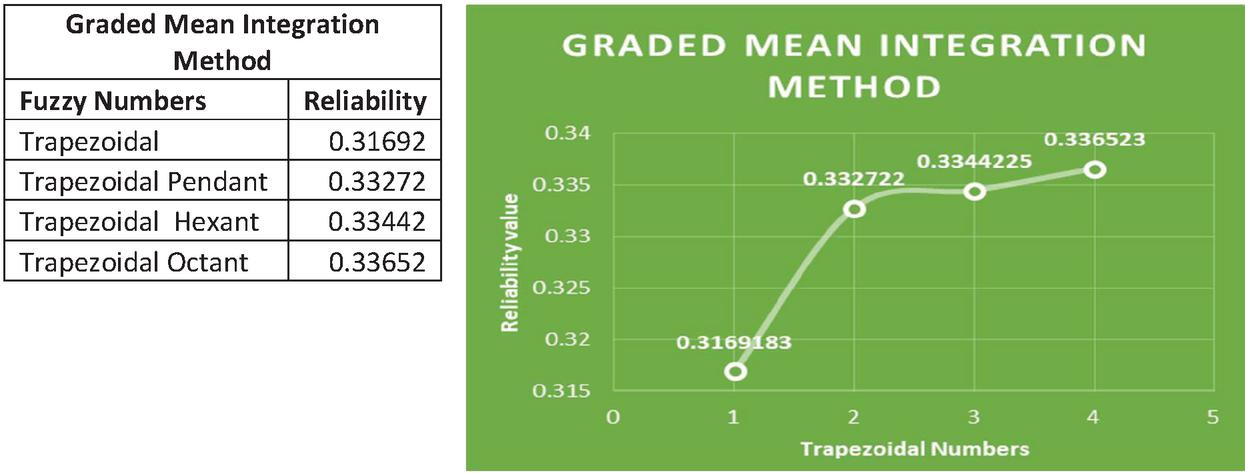 |
Table and Graph 6 Graded Mean Integration Method of Pentagonal, Pentagonal Pendant, Pentagonal Hexant and Pentagonal Octant Fuzzy numbers
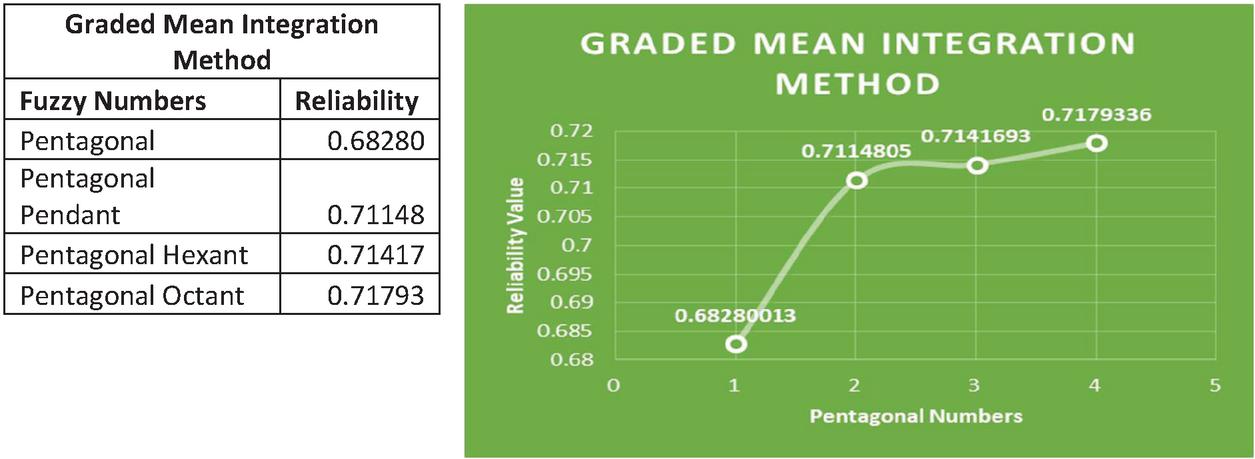 |
6.1.3 Centroid Method
Table and Graph 7 Centroid Method of Triangular, Triangular Pendant, Triangular Hexant and Triangular Octant Fuzzy numbers, Trapezoidal, Trapezoidal Pendant, Trapezoidal Hexant and Trapezoidal Octant Fuzzy numbers, Pentagonal, Pentagonal Pendant, Pentagonal Hexant and Pentagonal Octant Fuzzy number
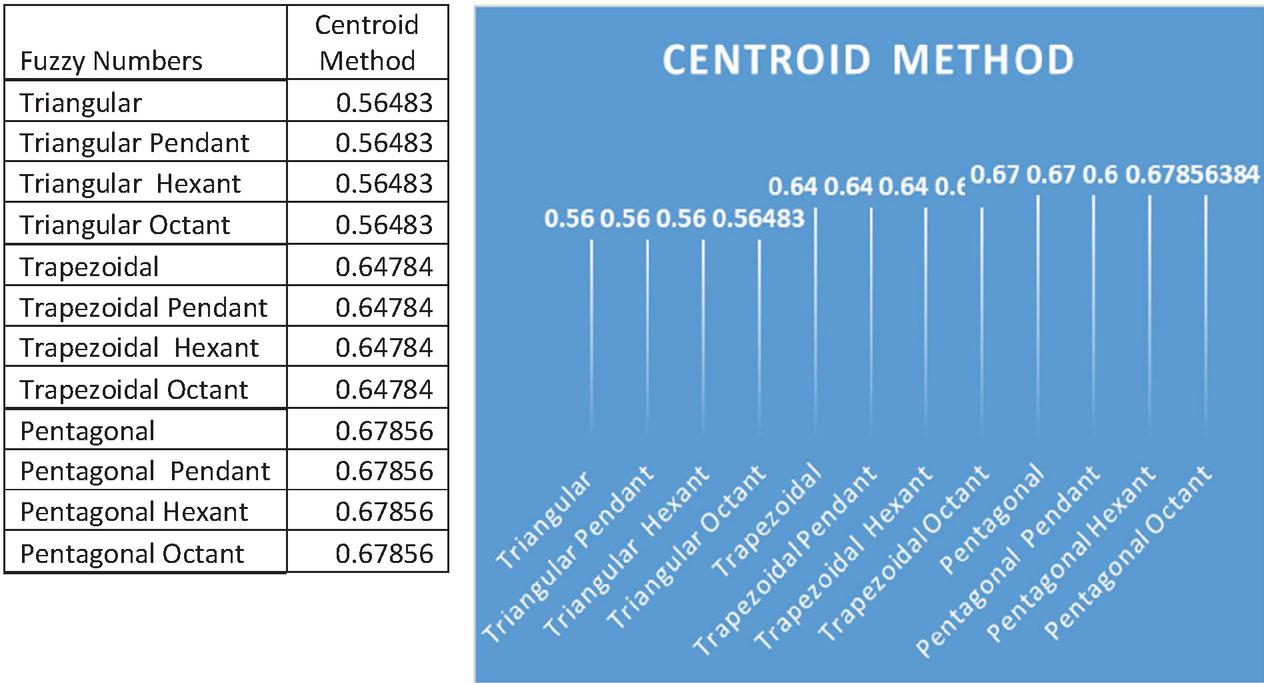 |
6.2 Representation of Reliability Through Table and Graph
Table and Graph 8 Reliability
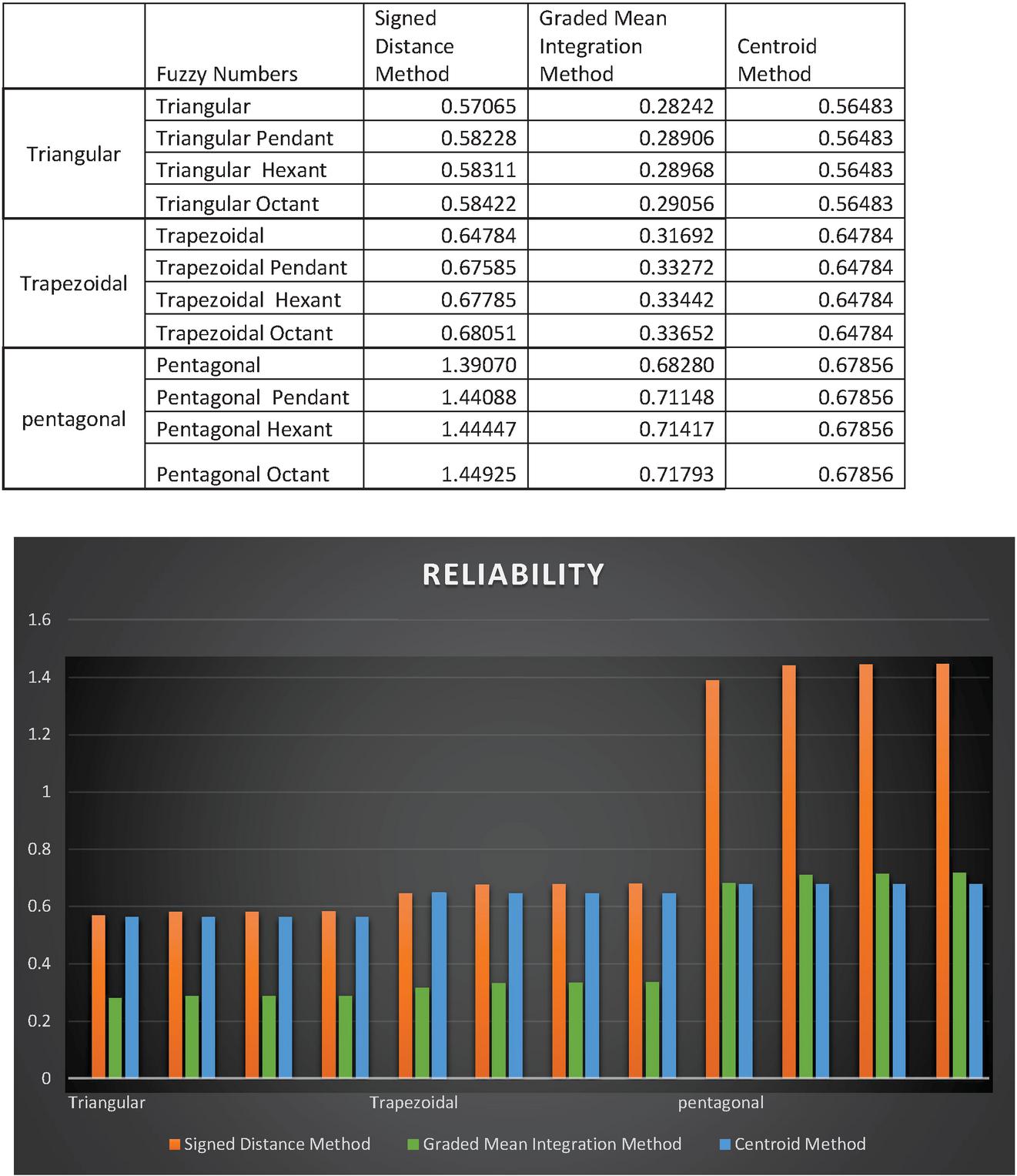 |
The comparison study of the Signed Distance Method, Graded Mean Integration Method, and Centroid Method is shown in the graph and tables above. Pentagonal cases are more reliable than triangular and trapezoidal situations in the Signed Distance Method. Triangular Octant Fuzzy Number is more reliable than Triangular Hexant Fuzzy Number and Triangular Hexant Fuzzy Number is more reliable than Triangular Pendant Fuzzy Number. The Triangular Pendant Fuzzy Number has a higher reliability than the Triangular Fuzzy Number. The same may be said for Trapezoidal and Pentagonal shapes. In the case of the Signed Distance Method, however, the increasing rates from a Fuzzy Number to its Pendant, Pendant to Hexant, and Hexant to Octant are the same. As a result, we can deduce that as the fuzzy number’s dimension increases, the system’s reliability increases as well. As a result, the system’s Reliability will increase when using the Signed Distance Method with a higher interval Fuzzy Number. All of the conditions mentioned are the same in the Graded Mean Integration Method as they are in the Signed Distance Method. However, as compared to the Signed Distance Method, the reliability value is much lower. But, Triangular Fuzzy Number, Triangular Pendent Fuzzy Number, Triangular Hexant Fuzzy Number, and Triangular Octant Fuzzy Number all have the same reliabilities when using the centroid approach. In the case of Trapezoidal and Pentagonal, the reliabilities are the same. The main disadvantage of the Centroid Method is that different Triangular Fuzzy Numbers provide the same level of reliability. As a result, we are unable to achieve exact reliability in the Centroid Method for various fuzzy values. The graphs above illustrate the reliability’s entire structure.
7 Conclusion
According to the results of the above mentioned analysis, the system’s reliability will improve when the Signed Distance Method is applied for defuzzification. In addition, regardless of defuzzification techniques, when the intervals in the fuzzy numbers increase, the system’s reliability value increases as well. When Pentagon Fuzzy numbers are used for the probability values, the system’s reliability value is higher than when Trapezoidal and Triangular Fuzzy numbers are utilised.
References
[1] Zadeh LA, Fuzzy sets,Information and control 8 (1965), 338–353.
[2] Panda DC, A new method for evaluation of fuzzy reliability of multistage interconnection. International Journal of Research and Reviews in Applied Sciences 3:14–20, (2016).
[3] He Q, Yabing ZHA, Zhang R, Sun Q, Liu T, Reliability analysis for multi-state system based on triangular fuzzy variety subset Bayesian networks. EksploatNiezawodnosc- Maintenance and Reliability 19:152–165 (2017).
[4] Mahapatra GS, Roy TK, Reliability of components using interval nonlinear programing. Electronic Journal of Applied Statistical Analysis 5:151–163 (2012).
[5] Jamkhaneh EB, An evaluation of the systems reliability using fuzzy lifetime distribution. Journal of applied mathematics Islamic Azad University of Lahijan 7:73–80 (2011).
[6] Hussian MA, Amin EA, Fuzzy reliability estimation for exponential distribution using ranked set sampling. International Journal of Contemporary Mathematical Sciences 12:31–42 (2017).
[7] Alive IM, Kara Z, Fuzzy system reliability analysis using time dependent fuzzy set. Control and Cybernetics Journal 33 653-662 (2004).
[8] Dong YG, Chen XZ, Cho HD, Kwon JW, Simulation of fuzzy reliability indexes, Journal of Mechanical Science and Technology 17:492–500, (2003).
[9] Wu HC, Fuzzy reliability estimation using Bayesian approach. Computers and Industrial Engineering, 46:467–493, (2004).
[10] Sharma MK, Possibility and Probability aspect to fuzzy reliability analysis of a network system. Global Journal of Pure and Applied Mathematics, 13; 3641–3655, (2017).
[11] Kumar G, Bajaj RK, Intuitionistic fuzzy reliability of K-out-of-N: G system using statistical confidence interval, International Journal of Applied Information Systems 7:1–7, (2014).
[12] Chaube S, Singh SB, Fuzzy reliability of two-stage weighted-k-out-of-n systems with common components, International Journal of Mathematical Engineering and Management Sciences 1:41–51, (2016).
[13] Lee HM, Fuh CF, Su JS, Fuzzy parallel system reliability analysis based on level interval-valued fuzzy numbers, International Journal of Innovative Computing Information and Control 8:5703–5713, (2012).
[14] Kumar M, Yadav SP, A novel approach for analyzing fuzzy system reliability using different types of intuitionistic fuzzy failure rates of components, ISA Transactions 51:288–297, (2012).
[15] Kumar M, Yadav SP, Kumar S, Fuzzy system reliability evaluation using time-independent intuitionistic fuzzy set, International Journal of Systems Science 44:50–66, (2013).
[16] Razak KA, Rajakumar K, A study on fuzzy reliability measures, Applied Mathematical Sciences 7:3335–3343, (2013).
[17] Rao KD, Kushwaha HS, Verma AK, Srividya A, Anew uncertainty importance measure in fuzzy reliability analysis, International Journal of Performability Engineering 5:219–226, (2009).
[18] Xu X, Mithra J, Distribution system reliability evaluation using credibility theory, International Journal of Engineering Science and Technology 2:107-118, (2010)
[19] Rezvani S, Multiplication Operation on Trapezoidal Fuzzy numbers, Journal of Physical Sciences, vol no-15, 17–26 (2011).
[20] Praveen Prakash A and Geetha Lakshmi M, A Trident Fuzzy Number and its Arithmetic Operations, International Journal of Innovative Research in Computer and Communication Engineering, vol no-4(10) (2016).
[21] Rama B and Michael Rosario G, Inventory model with penalty cost and shortage cost using trident fuzzy numbers, International Journal of Artificial Intelligence and Soft Computing, vol no-7–issue 1, pp. 59–85, 2019.
[22] Rama B and Michael Rosario G, Quadrant Fuzzy Number and its Arithmetic Operations, Journal of Computer and Mathematical Sciences, vol no-10(7), 1466–1475 July 2019.
[23] Nagoorgani A, A new operation on triangular fuzzy number for solving fuzzy linear programming problem, Applied Mathematical Sciences, 6, 525–532 (2012).
[24] Avinash J. Kamble, Some Notes on Pentagonal Fuzzy Numbers, International Journal of Mathematical Archive, Vol no-13(2), 113–121, (2017).
[25] Menaka G, Ranking of Octagonal Intuitionistic Fuzzy Numbers, IOSR Journal of Mathematics, vol 13 issue 3 Ver. II, pp. 63–71, (2017).
[26] Rezvani S, “Ranking generalized exponential trapezoidal fuzzy numbers based on variance”, Applied Mathematics and Computation, (2015).
[27] HesamoddinTahami and HengamehFakhravar “A Fuzzy Inventory Model Considering Imperfect Quality Items with Receiving Reparative Batch and Order”, European Journal of Engineering Research and Science, (2020).
[28] RituparnaPakhira, Uttam Ghosh and Susmita Sarkar “Study of Memory Effect in a Fuzzy EOQ Model with No Shortage”, International Journal of Intelligent Systems and Applications, (2019).
[29] SankarPrasadMondal, Manimohan Mandal and Debasish Bhattacharya. “Non-linear interval valued fuzzy numbers and their application in difference equations”, Granular Computing, (2017).
[30] Michael Rosario G and Dhanalakhmi A, “Intuitionistic Fuzzy Equations and its Application on Reliability Evaluation”, ‘International Journal of Advanced Technology Engineering and Science’, Volume 03, Number 03, March (2015).
[31] Srinath LS, Reliability Engineering, Fourth Edition, Affiliated East-West Press Private Limited – (2016) (Text Book).
[32] Charles E. Ebeling, An Introduction to Reliability and Maintainability Engineering, McGraw Hill Education India private Limited – (2017).
[33] Jini Varghese P and Michael Rosario G, Fuzzy reliability evaluation of weaving machine in textile industry, International Journal of Mathematical Archieve, vol. 9. no. 1, ISSN 2229-5046, (2018).
[34] Jini Varghese P and Michael Rosario G, some arithmetic operations in trapezoidal Fuzzy numbers and intuitionistic trapezoidal Fuzzy numbers, Journal of Applied Science and Computations, vol. 5, issue 122018, 40–49, (2019).
[35] Jini Varghese P and Michael Rosario G. “Fuzzy Probist System Reliability of Weaving Machine in Textile Industry”, IOP Conference Series: Materials Science and Engineering, (2021).
Biographies

P. Jini Varghese received the bachelor’s degree in Mathematics from Mahathma Gandhi University, Kottayam, Kerala in 2006, the master’s degree in Mathematics from Mahathma Gandhi University, Kottayam, Kerala in 2008, and bachelor of Education in Mathematical Science from Mahathma Gandhi University, Kottayam, Kerala in 2009, respectively. She is currently working as an Assistant Professor at the Department of Basic Science and Humanities in Adi Shankara Institute of Engineering and Technology, Kalady, Kerala affiliated to Kerala Technical University. Her research area is Fuzzy Reliability and published many papers in highly-reputed journals.

G. Michael Rosario was the Head & Associate Professor (Rtd), Research Centre of Mathematics, Jayaraj Annapackiam College for Women (Autonomous), Periyakulam, Theni- District, TamilNadu, India. She is having 37 years of teaching experience and 15 years of research experience. She is senior member of “Operational Research Society of India”, with effect from July28, 2013. Her main areas of research include Applied Probability Theory, Application Of Marker Decision Process, Reliability in Service Facility System, Fuzzy Set theory, Fuzzy Inventory Models and Fuzzy Reliability Evaluation.
Journal of Reliability and Statistical Studies, Vol. 14, Issue 2 (2021), 491–526.
doi: 10.13052/jrss0974-8024.1426
© 2021 River Publishers
